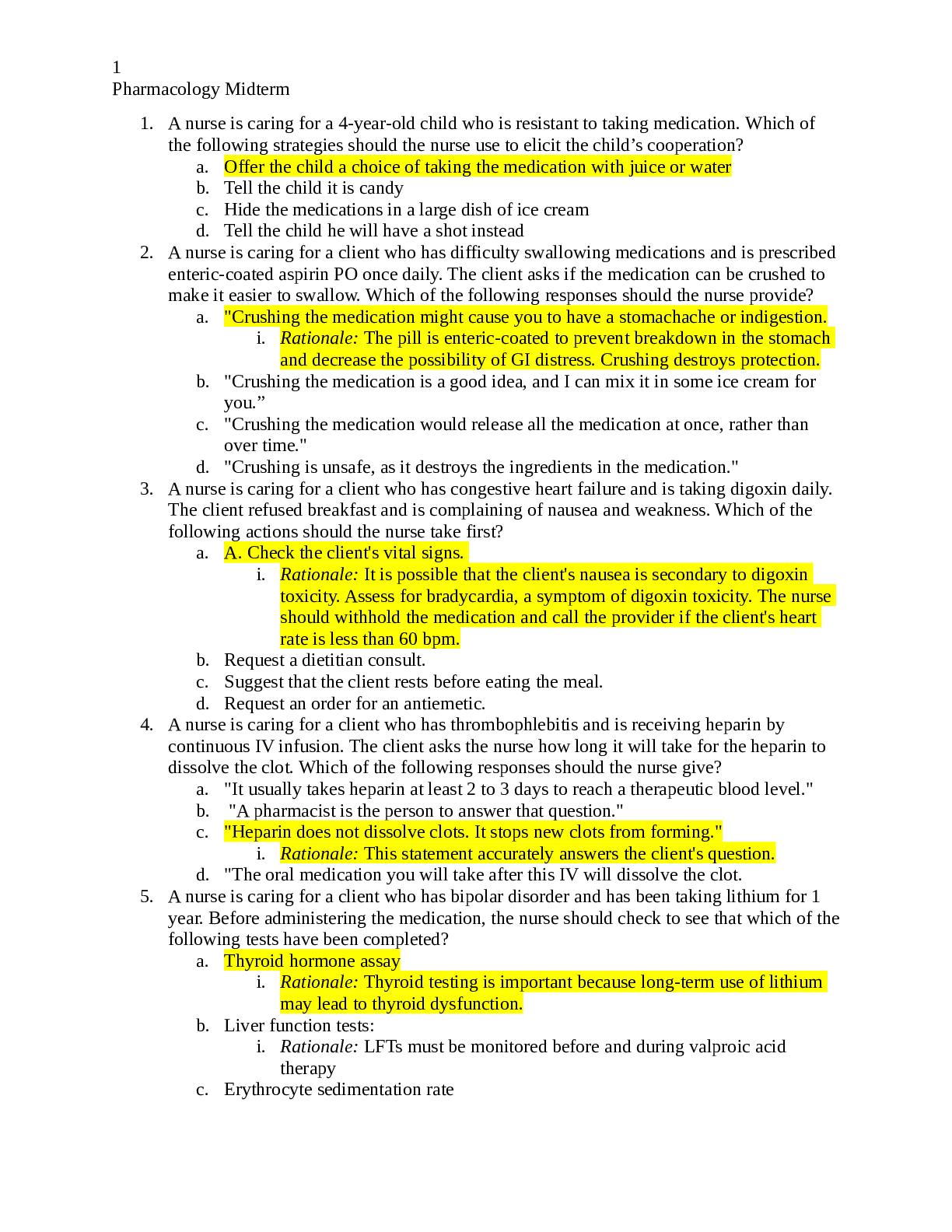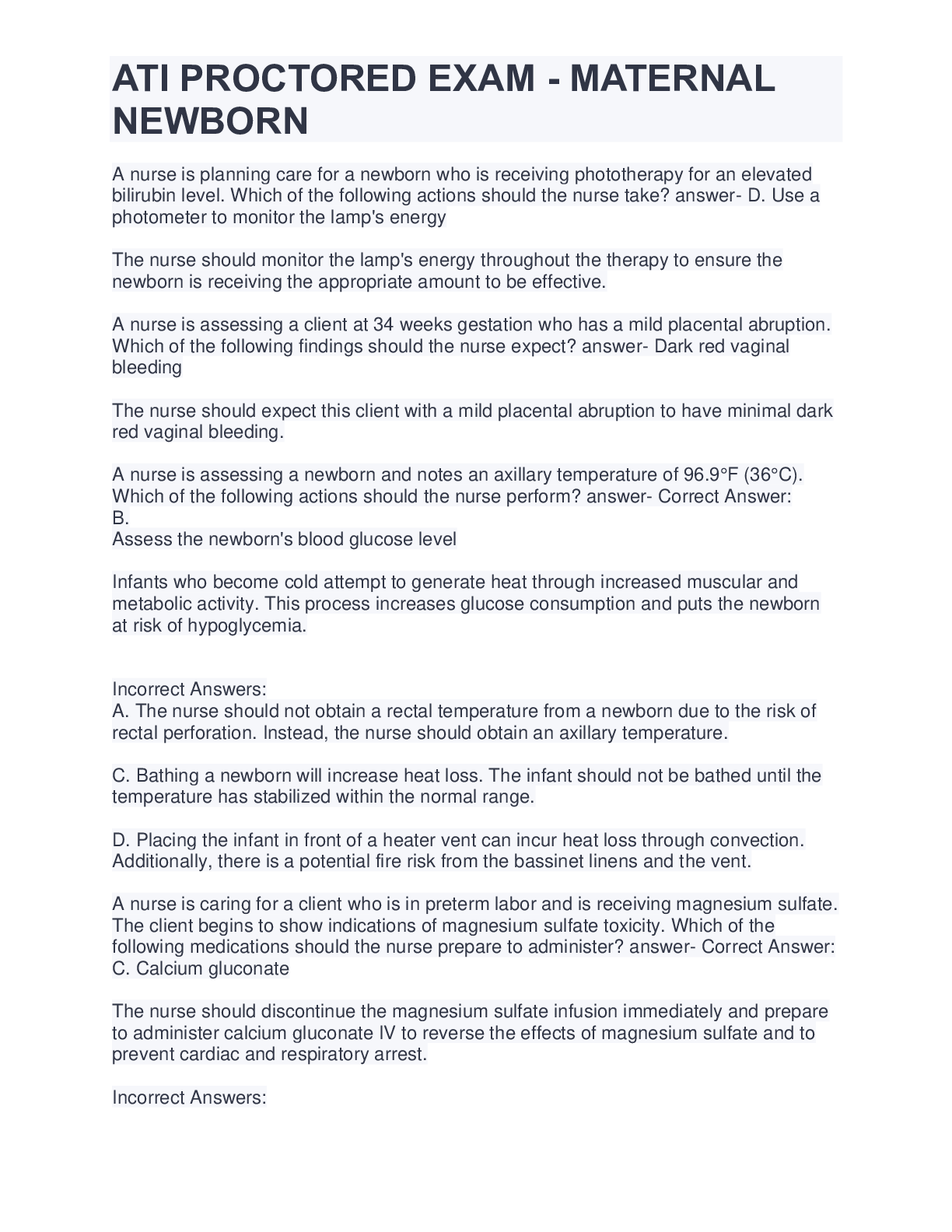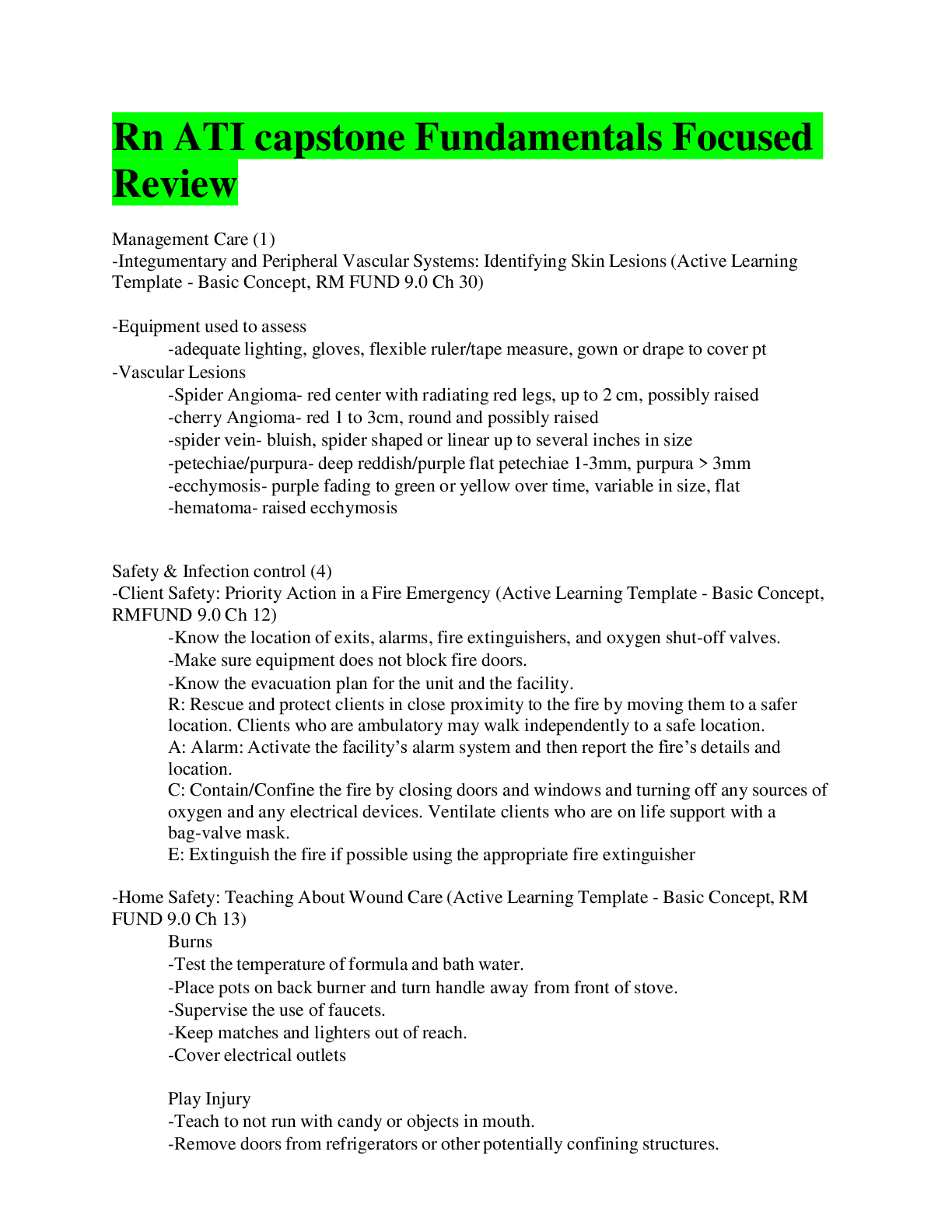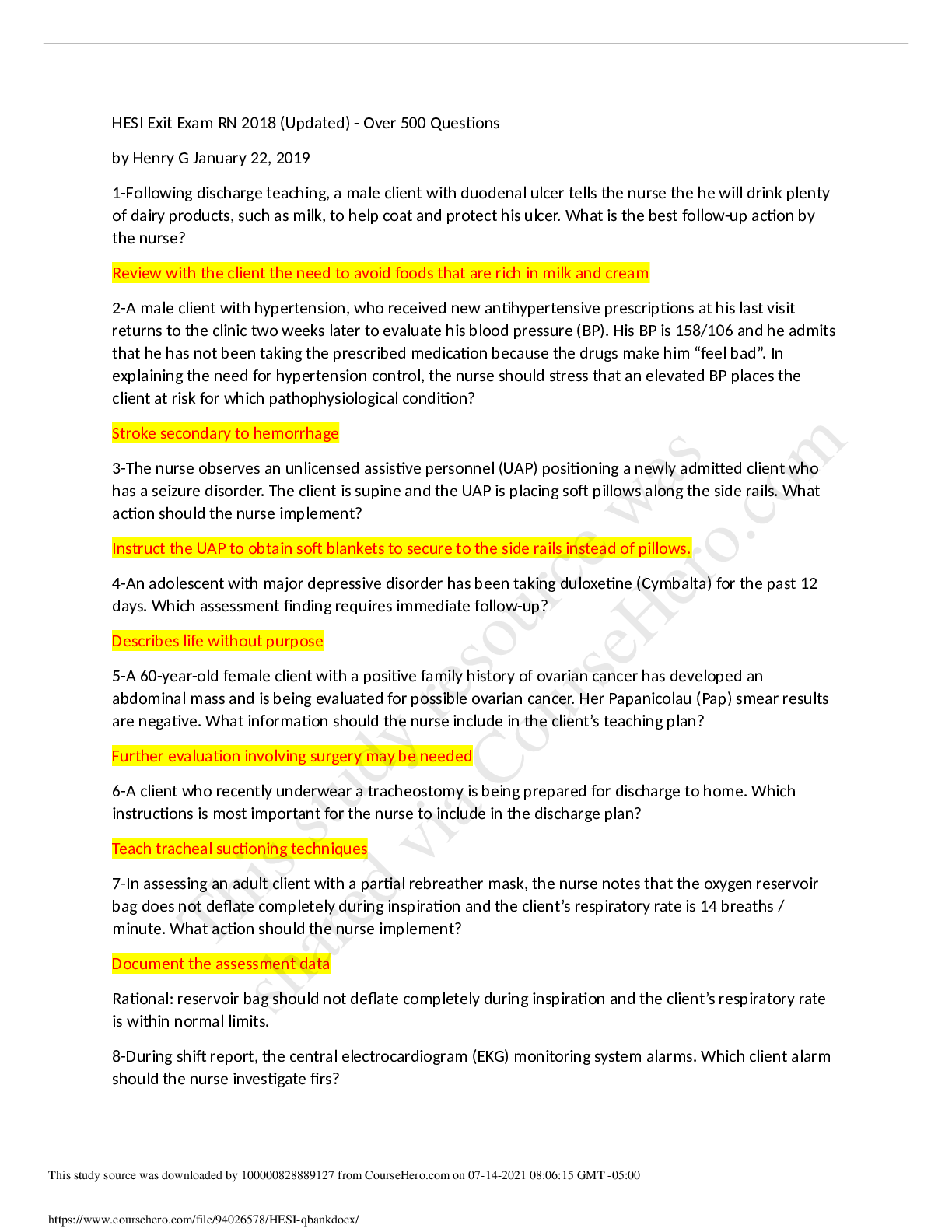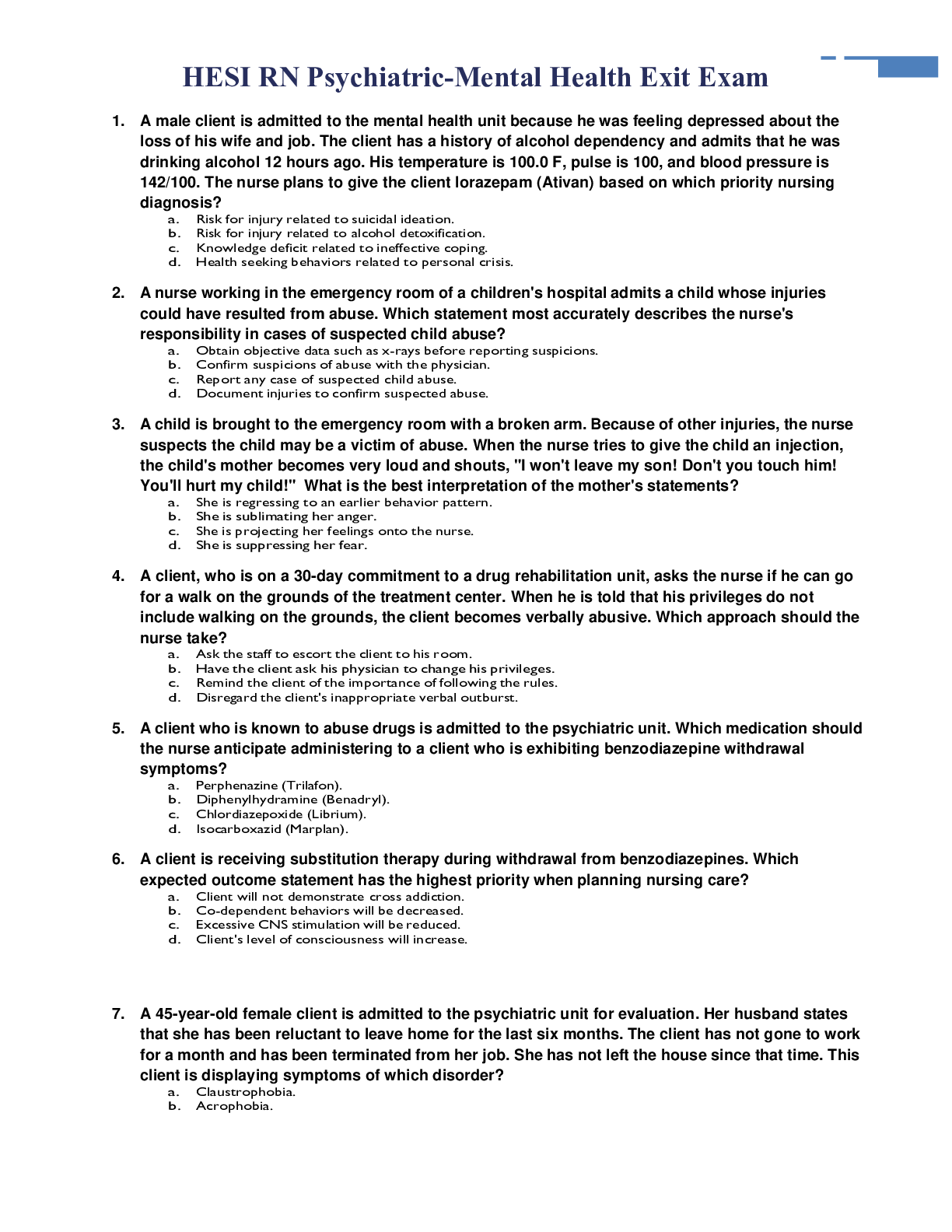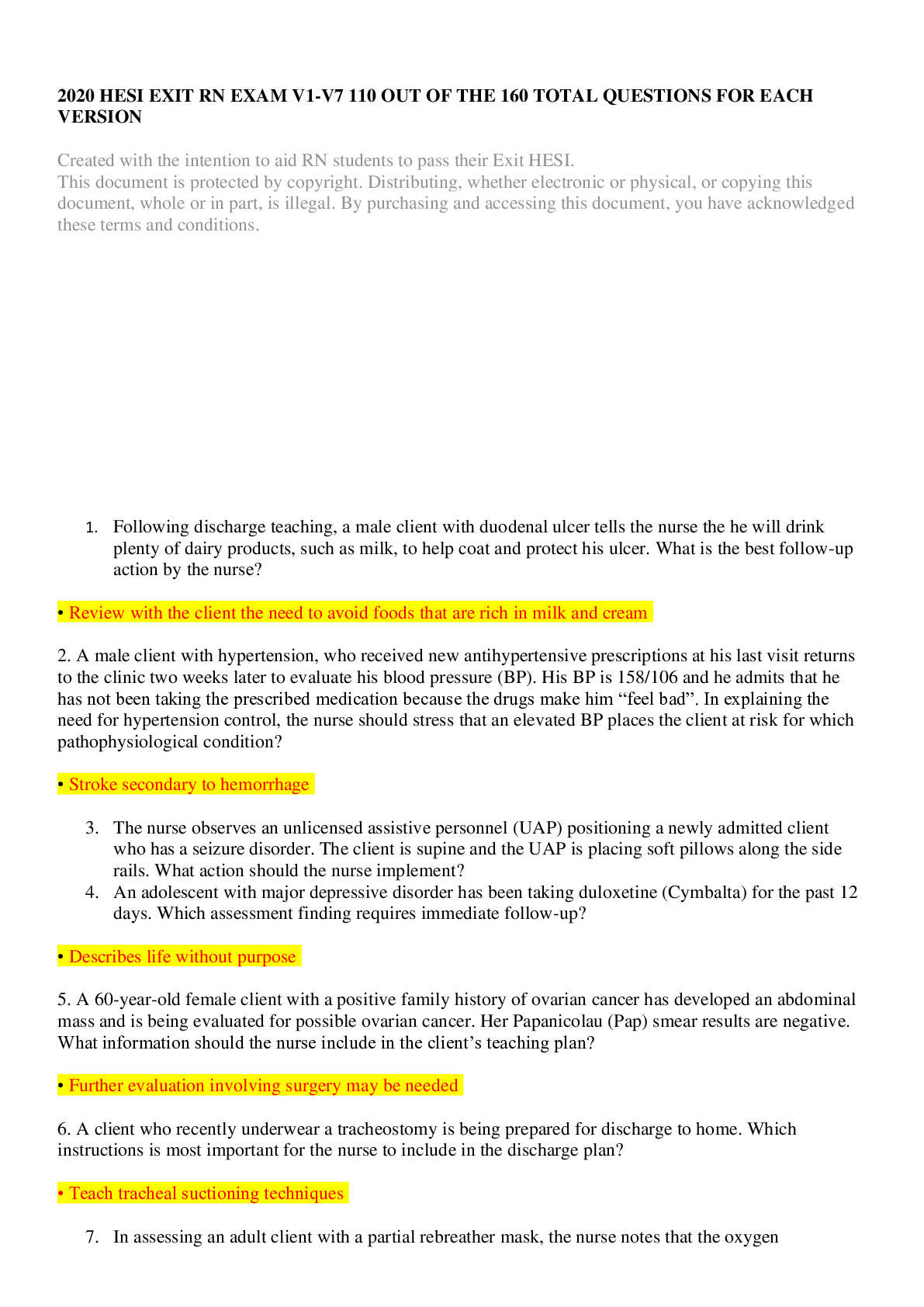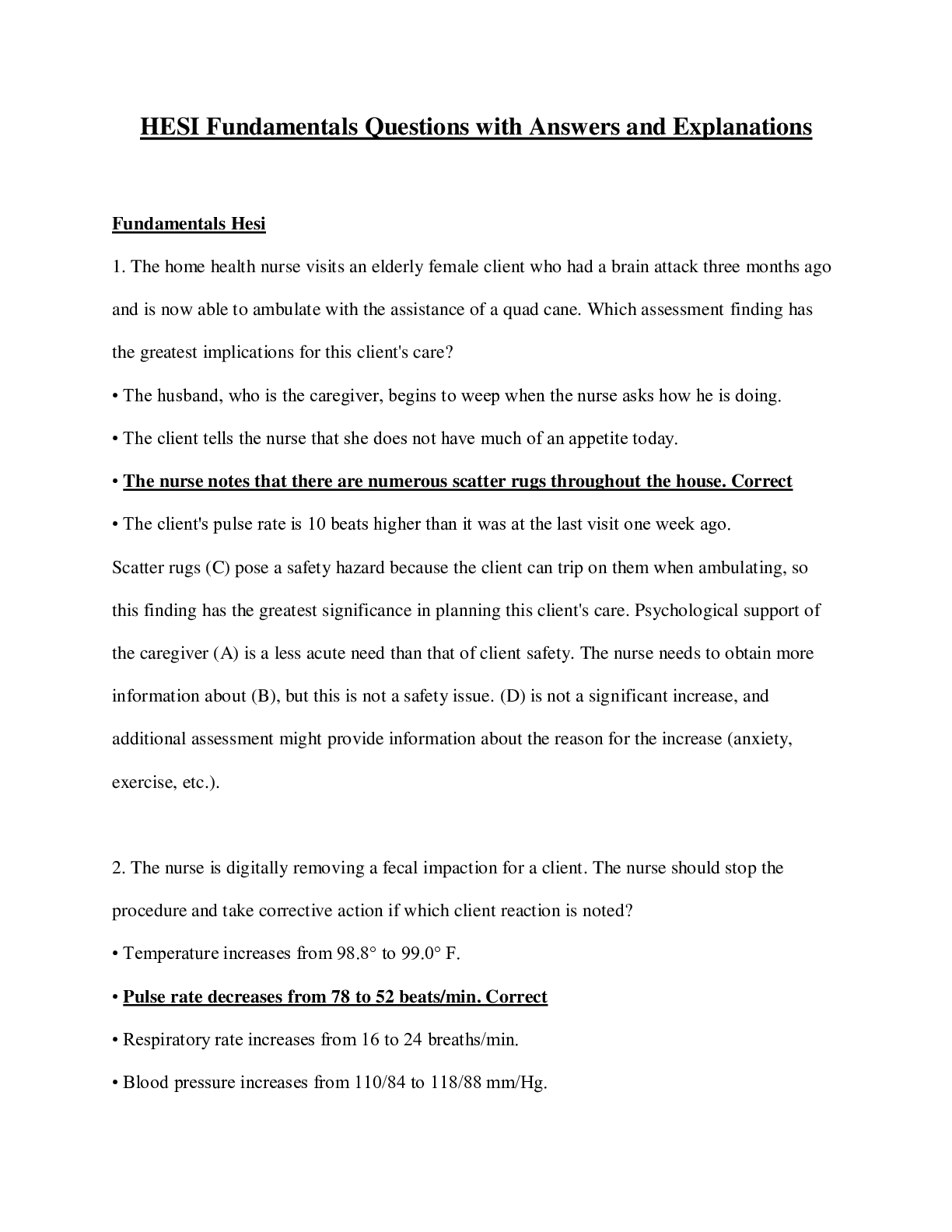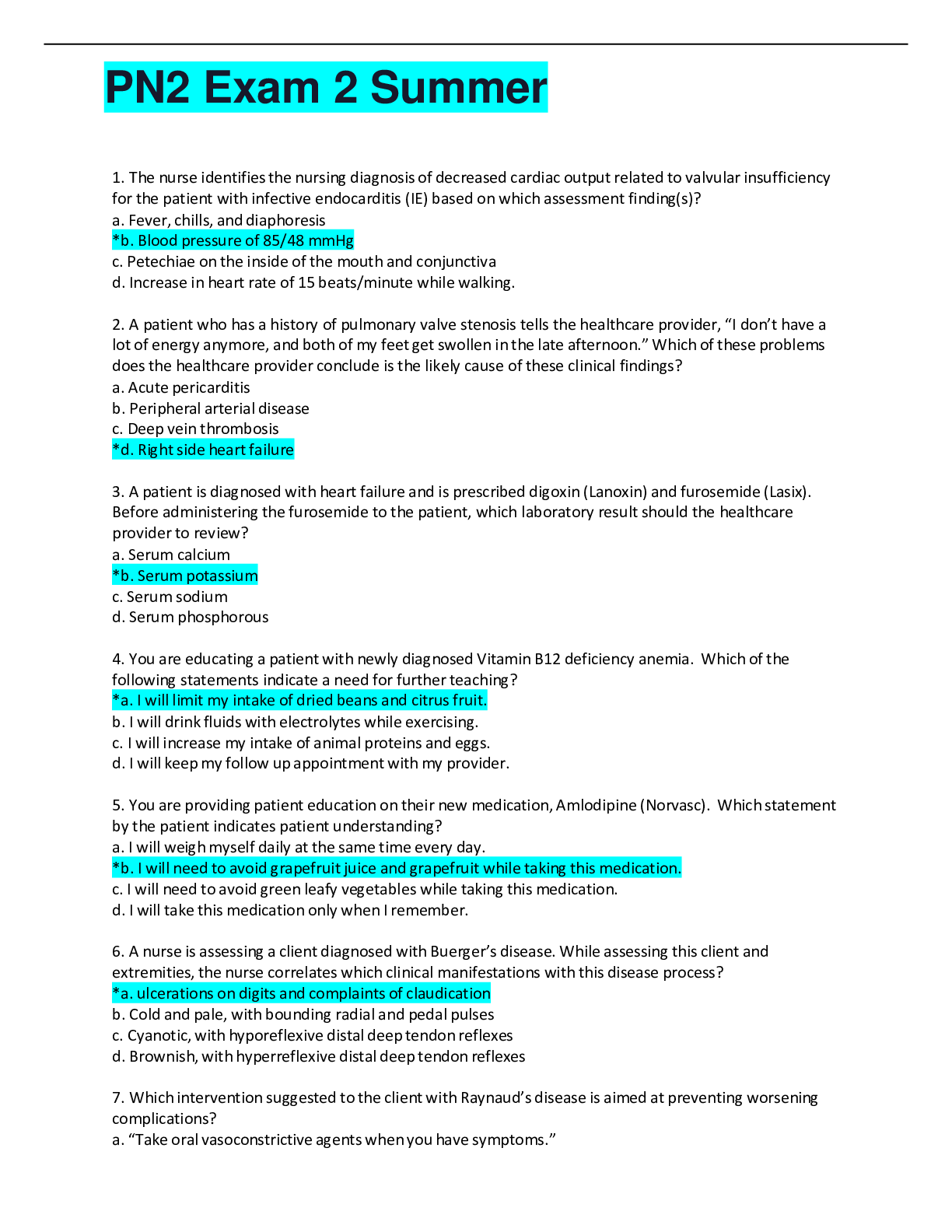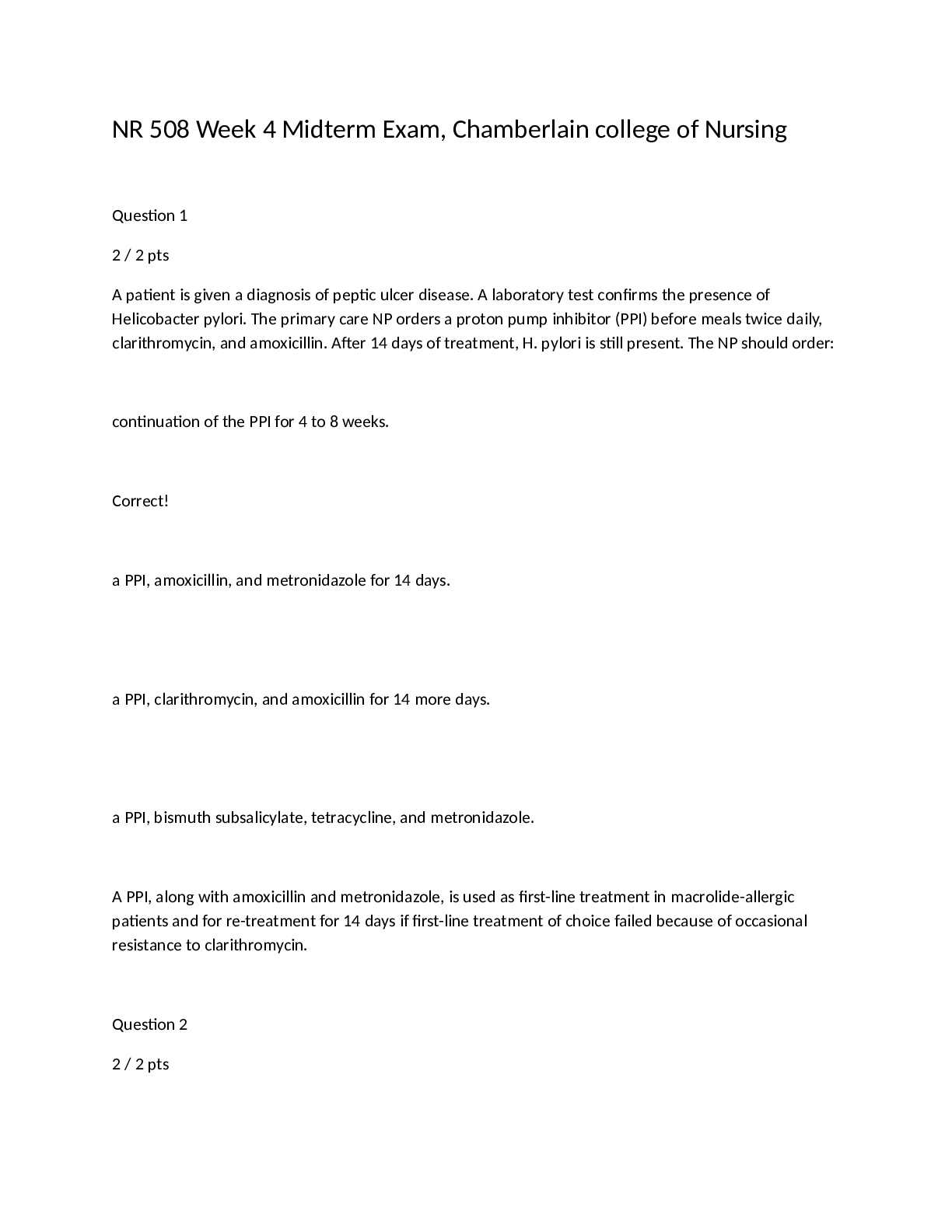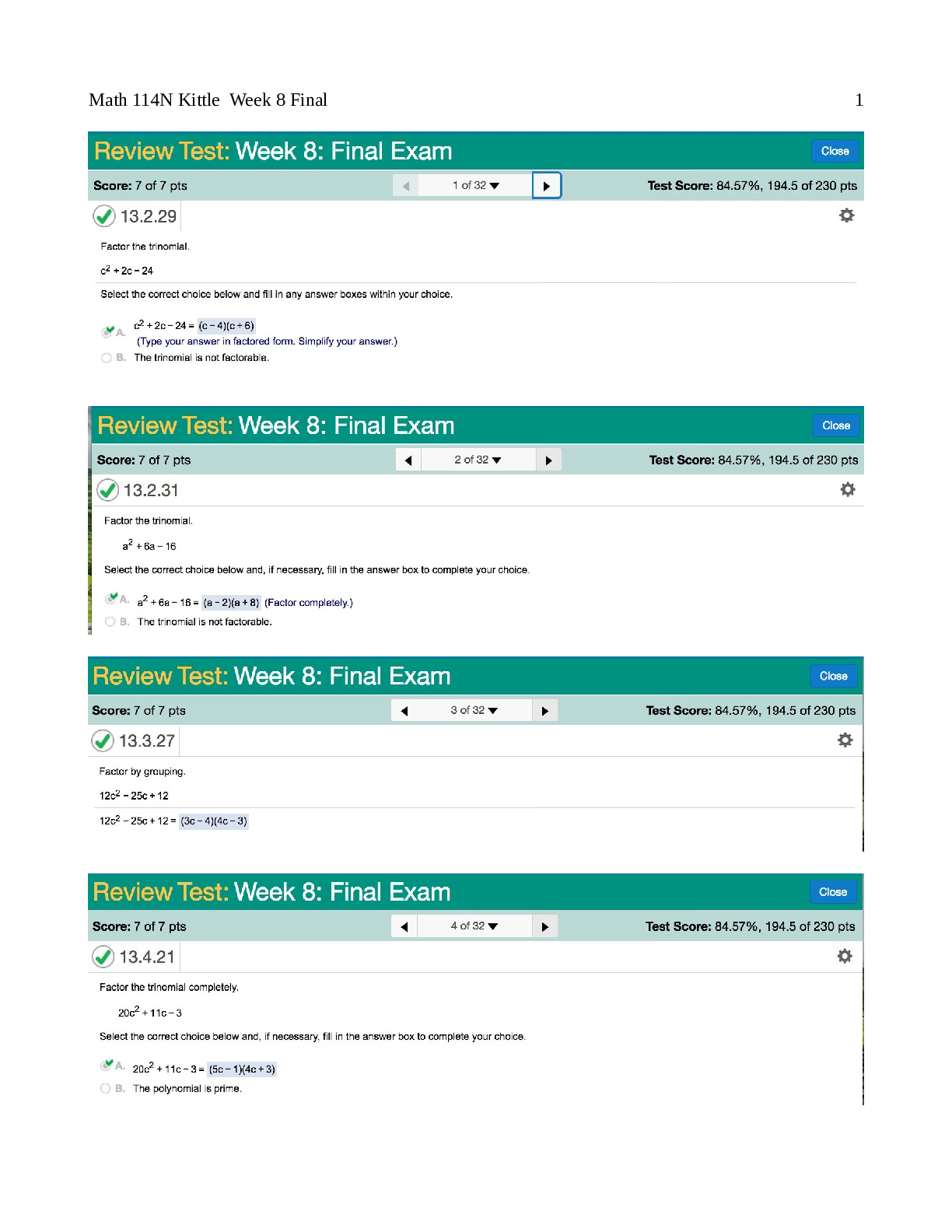Foreign Languages > EXAM > South University - FCCA 274 A / FCCA 274 A Exam LATEST AND GRADED A+ (All)
South University - FCCA 274 A / FCCA 274 A Exam LATEST AND GRADED A+
Document Content and Description Below
FCCA 274 A Exam 1. Which statement by an older adult during the health history indicates the person is at a high risk for falls and needs further evaluation? a. “My spouse’s things clutter my hous... e.” b. “I recently had cataract surgery.” c. “It helps me when I focus on one thing at a time.” d. “I will be 64-years-old this month.” 2. The RN is making a home visit to conduct a health history for a patient who will require assistance in the home following an extensive surgical procedure. As the RN prepares to depart the residence, the child below is whimpering. The patient says “He does not talk. He’s whining because he is clumsy and fell down again.” What action is the RN responsible to perform in relationship to this child? a. Contact Child Protective Services. b. Make arrangements for a follow-up visit. c. Assess the family members’ response to stress. d. Conduct a focused assessment on the child. 3. During a spiritual assessment, which question by the RN helps explore a person’s inner strength? a. “What religious community do you belong to?” b. “Do you routinely attend religious services?” c. “What beliefs help you cope with life’s difficulties?” d. “Would speaking with a chaplain help you and your family?” 4. How does the RN conclude a routine health history interview with the parent of an infant? a. “Is there anything more you would like to discuss?” b. “The physical examination should not take too much time.” c. “You are providing good care for your baby.” d. “How are you feeling now about the baby’s health? “ 5. The RN is obtaining a health history from a middle-aged adult patient. Which question allows for comprehensive data regarding the patient’s physical fitness? a. “Can you describe your typical daily activity level?” b. “How often do you reach your target heart rate?” c. “Do you routinely participate in a sports activity?” d. “What benefits do you experience when exercising?” 6. During a health assessment, the RN asks “Do you have an advance health care directive?” The patient asks “Why do I need that? Is my condition that serious?” What is the appropriate response by the RN? a. “A power of attorney can make your health care decisions if you are unable.” b. “The written form will direct the health care team not to perform resuscitation activities.” c. “Documenting your desired treatment goals will help guide your health care.” d. “Once completed and witnessed, the form is legally binding in all states.” 7. While conducting a health history for a 12-year-old, a parent asks the RN “Do you think it is a good idea for my child to get the Human Papillomavirus (HPV) vaccine?” What is the appropriate response by the RN? a. “The vaccine is not needed until your child becomes sexually active.” b. “The vaccine needs to be given in early adolescence to be effective.” c. “The recommendation is to begin the series of injections now to provide protection.” d. “The best protection for your child is to reinforce abstinence from sexual relations.” 8. The patient states “I had some dizzy spells at home.” What is the RN’s initial response? a. “Did you feel faint?” b. “Was the room spinning?” c. “Were you anxious?” d. “What do you mean by dizzy?” 9. Which statements made by a parent to the RN raises concerns about a child’s risk for maltreatment? Select all that apply a. “I restricted use of all electronic toys because of my child’s behavior.” b. “I really did not plan or want to have children until I finished school.” c. “Some days this baby is nothing but trouble.” d. “I wish my child would not cry when my new significant other is present.” e. “A glass or two of wine during the day helps me cope with the stress of parenting.” 10. In providing culturally competent care, which question by the RN during the health history will provide information regarding the patient’s health beliefs? a. “What kinds of treatment do you think help you?” b. “How long have you lived in the United States?” c. “When was the last time you obtained healthcare?” d. “Does your family eat heart healthy foods?” 11. The RN is performing a health history on a 14-year-old male who states “I was born the wrong gender. I don’t like my body parts.” What areas should the RN assess as potential issues associated with the client’s concern? Select all that apply. a. Anxiety b. Delusions c. Depression d. Dissociations e. Mania 12. When asked by the RN during a health history, the young adolescent states “I have a few cigarettes occasionally with my friends.” What is an appropriate initial response by the RN? a. “When you smoke, do you also drink alcohol?” b. “Do your parents know and approve of you smoking?” c. “Did you know once you start smoking, it is difficult to quit?” d. “Can you tell me more about your cigarette use?” 13. The RN is reviewing the health history of a woman who is considering pregnancy. Which patient statement indicates to the RN the need for genetic referral? a. “My husband needs to quit smoking cigarettes.” b. “I am 32-years-old and will be a first time older mother.” c. “I had pre-eclampsia during my last pregnancy.” d. “My husband had a cleft lip repair as a child.” 14. When the RN explores family history during a health assessment, which patient statement identifies a potential area of concern? a. “My father committed suicide at the age of 35.” b. “My aunt died from a ruptured appendix when she was 10-years-old.” c. “My sister developed a hearing impairment after she took antibiotics as a child.” d. “My grandfather is 80-years-old and has dementia.” 15. When an RN performs medication reconciliation during the health history, which statement by a patient who is in the first trimester of pregnancy requires intervention? a. “I drink orange juice when I take my iron tablets.” b. “I take naproxen (Aleve) when I have headaches.” c. “I got my influenza vaccine one month ago.” d. “I drink one cup of coffee every morning.” 16. The RN is conducting a health history on a person who happens to be a close relative of a co-worker. The co-worker asks the RN about the abnormal findings the relative shared. What is the appropriate response the RN makes to the co-worker? a. “The interview process is confidential.” b. “I’ll know more when the laboratory reports are completed.” c. “The information is in the medical record.” d. “You should have asked to be present during the interview.” 17. A RN is completing a health history on an older adult. Which remark is appropriate when beginning to inquire about sexual health? a. “Let me pull the curtain around the bed before we discuss this topic.” b. “How is your relationship with your partner?” c. “I have to ask the next few questions on sex.” d. “Since your spouse recently died, do you want to skip the questions on sex?” 18. What information from the health history is relevant prior to the room assignment for a patient admitted for watery diarrhea? a. Current illicit intravenous drug use. b. Recent tattoos to bilateral arms. c. Treatment for lung cancer 5 years previously. d. Recent antibiotic treatment for cellulitis. 19. Which statement by the patient during a focused nutritional assessment provides the RN with the most accurate information about diet? a. “I eat cereal for breakfast; a sandwich and fruit for lunch; meat and potatoes for dinner.” b. “Here is a list of what I ate, including between meal snacks, for the past few days.” c. “I have eggs 4 times a week; I eat fish a few times a week; salads and soups every day.” d. “I follow a gluten-free diet and feel much better since getting back to my normal weight.” 20. Which statement made by the RN is most appropriate to begin a comprehensive health history with an older adult patient? a. “Hello, Bob. I am Vickie Smith and I need to ask you a few questions.” b. “Hello. My name is Vickie and I will be doing your health assessment now.” c. “I am Vickie, your nurse. I have a few questions. This won’t take too long.” d. “Hello, Mr. Jones. I am Vickie Smith, RN. I have some questions to ask you.” 21. The unlicensed assistive personnel (UAP) tells the RN about being unable to obtain a blood pressure on a patient who has a Body Mass Index (BMI) of 60. What is the RN’s response? a. “Let’s ask the patient the best method to obtain a blood pressure.” b. “I’ll show you how to use the forearm and listen to the radial pulse.” c. “I will ask the health care provider if obtaining routine blood pressures are necessary.” d. “Try using the electronic machine and hold the cuff ends together.” 22. A patient admitted to the hospital with pneumonia tells the RN “I do not think I can stand up to be weighed.” What is the most appropriate action by the RN? a. Request that the patient estimates current weight. b. Use the last weight recorded in the electronic medical record. c. Have the unlicensed assistive personnel (UAP) obtain a bed scale weight. d. Weigh the patient on the standing scale when extra personnel are available. 23. Which reflex is the RN assessing in the image below? a. Moro b. Tonic neck c. Stepping d. Babinski 24. A patient with a non-healing foot wound reports increased thirst and frequent urination to the RN during the communication period prior to conducting a physical exam. Which laboratory test does the RN anticipate will be ordered when this information is shared with the health care provider? a. Blood Urea Nitrogen (BUN) b. Serum albumin level c. Capillary blood glucose level d. Thyroid-stimulating hormone (TSH) 25. A patient with acute pancreatitis reports “feeling lightheaded.” Which assessment does the RN identify as the priority? a. Blood pressure and heart rate. b. Abdominal inspection. c. Serum glucose level. d. Neurological status. 26. On the physical exam, the RN notes that a patient has a beefy red, smooth-appearing tongue. Which area requires a more in-depth assessment? a. Nutrition b. Hydration c. Respiratory d. Cardiac 27. The school nurse is performing routine health assessments during the first month of school. For which health condition is the RN screening in this image? a. Scoliosis b. Asthma c. Lordosis d. Osteoporosis 28. During an outpatient physical assessment, the RN sits the older adult client in a chair and performs the Get up and Go Test. The client uses the arms of the chair to push off to a standing position and is unsteady when sitting back down. What is the initial action by the RN? a. Assess the client’s muscle strength b. Complete a Safety Assessment Scale c. Perform a comprehensive fall evaluation. d. Conduct a follow-up assessment. 29. The RN notes a patient‘s breathing pattern is cyclical with a gradual increase in depth followed by gradual decrease then a period of apnea. Which system requires a more in-depth assessment by the RN? a. Musculoskeletal b. Neurological c. Psychological d. Gastrointestinal 30. Which picture demonstrates that the RN used established guidelines when applying a blood pressure cuff? a. b. c. d. 31. A child experiences ringing in the ears and dizziness after being kicked in the head during a soccer game. Which assessment finding by the RN requires immediate attention by the health care provider? a. Amnesia of the event. b. Feelings of anorexia c. Sensitivity to light and sound. d. Eyes deviated to the left. 32. Which assessment technique is the RN applying to gather data for a patient reporting problems with urinary elimination in this image? a. Inspection b. Palpation c. Percussion d. Auscultation 33. The RN informs the patient about the need to conduct an abdominal assessment. The patient takes a deep breath and then tenses the abdominal muscles. How does the RN proceed? a. Explain the importance of the examination. b. Ask the patient to count aloud to ten. c. Tell the patient the exam will not hurt. d. Omit palpation from the examination. 34. What is the primary problem with the apical pulse assessment shown in this image? a. The mother is holding the child. b. The child is distressed and crying. c. The mother is not wearing a gown. d. The child is not in a supine position. 35. A woman’s baby was delivered by surgical intervention. Which post-operative physical assessment requires the RN to immediately notify the physician/provider? a. Small amount of rubra lochia. b. Hard, guarded abdomen upon palpation. c. Dullness with percussion over the public symphysis. d. Bowel sound frequency of 5 to 10 per minute. 36. What is the best approach for the RN when performing a physical assessment on an infant?? a. Request that the parent leave the room during the procedure. b. Ask the parent to completely undress the infant prior to the examination. c. Suggest the parent remain quiet during the procedure. d. Have the parent hold the infant during the examination. 37. The RN performs an orientation assessment on an older adult with cognitive impairment who is disoriented to time and place. Which documentation statement accurately describes the RN’s findings? a. The patient is demented and cannot identify person, place, or time. b. The patient is pleasantly confused to time, place and person. c. The patient states the year is 1980 and is currently at church. Does recognize spouse. d. The patient’s responses are inappropriate and is requesting to leave this hotel. 38. The unlicensed assistive personnel (UAP) reports to the RN that the new patient has a “terrible” odor coming from the genital area. What is an appropriate response by the RN? a. “Did you notice any other abnormalities?” b. “I will need to do a focused skin assessment.” c. “Did the patient identify the timing of the last shower taken?” d. “Be sure to use talc powder to help control the odor.” 39. A patient presents with abdominal discomfort with infrequent bowel movements and difficulty passing stool. The abdominal assessment performed by the RN reveals a firm, slightly distended abdomen with hypoactive bowel sounds. Which areas does the RN explore with the patient? Select all that apply. a. Medications b. Fluid intake c. Activity level d. Hygiene practices e. Dietary fiber 40. During a patient’s physical assessment, the RN notes the following: How does the RN interpret this clinical finding? a. There is an acute circulation problem. b. The patient smokes cigarettes. c. The finding indicates rheumatoid arthritis. d. The patient may have chronic hypoxemia. 41. A patient with chronic pulmonary disease is admitted with pneumonia. Which of the following cues is considered insignificant and does not impact the patient’s current health concern? a. Weight loss of 5 pounds (2.3 kilograms) within the previous week. b. Family history of reactive airway disease. c. Bronchial breath sounds heard over bilateral lung fields. d. Contraction of abdominal muscles during inspiration. 42. A patient with a new diagnosis of cancer tells the RN “I just don’t know what to do. Several members of my family had cancer and the treatment was difficult.” Which is the priority nursing diagnosis? a. Ineffective health maintenance. b. Decisional conflict. c. Self-Care Deficit. d. Deficient knowledge. 43. Which nursing diagnosis is the highest priority when providing nursing care for a patient who has received moderate sedation? a. Anxiety b. Acute pain c. Risk for Ineffective Airway Clearance d. Risk for Deficient Fluid Volume unanswered 44. The RN applies the nursing diagnosis Activity intolerance related to heart failure as evidence by fatigue for a patient with chronic heart disease. The outcome is the patient will participate in self-care activities without a report of fatigue. What is the most effective action by the RN to assist the patient achieve the desired outcome after the patient is discharged from acute care? a. Obtain a referral for cardiac rehabilitation. b. Provide the patient with a handout of exercises. c. Encourage patient to do exercise in the morning. d. Identify a home-delivered meal service to conserve energy. 45. The patient with Impaired gas exchange has an expected outcome of maintaining oxygen saturation at 95% or greater. The patient’s oxygen saturation is 95% on 2 liters via nasal cannula but drops to 92% when the patient removes the oxygen. What nursing intervention is helpful to meet the patient outcome? a. Identify the need for more patient education. b. Continue the plan of care as the goal was partially met. c. Revise the plan of care with a different outcome. d. Explore barriers to achievement of the outcome with patient. 46. A child with autism spectrum disorder with history of hysterical reactions to change and limited verbal communication is admitted with pneumonia. What nursing diagnosis is appropriate to include in the child’s plan of care? a. Risk for injury. b. Risk for impaired social interaction. c. Compromised family coping. d. Ineffective health management 47. The RN assesses the patient with cancer who is receiving chemotherapy and notes the finding below. What is an appropriate nursing intervention? a. Provide commercial mouthwash to use after meals. b. Have patient use an electronic toothbrush. c. Encourage intake of iced carbonated drinks. d. Assess ability to chew and swallow foods/fluids. 48. A patient with the nursing diagnosis of Risk for Impaired Skin Integrity has the outcome of patient will not develop redness in the sacral area during hospital stay. The nursing intervention identified was to reposition the patient frequently. A day later, the patient’s sacral area was reddened. What areas should the RN explore when the outcome was not met? Select all that apply. a. The reassessment of patient specific risk factors. b. The ability of staff to follow the plan of care for all patients. c. Determination if the unit was adequately staffed. d. Whether the nursing order was clear and specific. e. Documentation reflects the nursing actions taken. 49. An older adult female is brought to the emergency department by a neighbor after found wandering outdoors. On physical exam, the woman is unclean, underweight, has multiple ecchymosis and small, reddened, circular areas on her arms and legs. After the patient has been stabilized, what action reflects the ethical responsibility of the RN? a. Notify the caregiver to give an update on the patient’s condition. b. Report the possible abuse to the state regulatory agency. c. Ask the neighbor about the basic living conditions. d. Explore the patient’s feelings about her living conditions. 50. A patient with end-stage kidney disease presents with fatigue, tachypnea, hypertension and pitting edema in the feet and sacral area. Based on the patient’s data cues, what is the etiology for the patient’s current condition? a. Edema in bilateral lower extremities. b. Increase in weight. c. Retention of sodium. d. Decrease in hemoglobin value. 51. A patient who had surgery to treat breast cancer, tells the RN: “My significant other cannot look me. I must look awful.” The RN identifies Disturbed body image related to loss of breast as a nursing diagnosis. What is an appropriate intervention by the RN? a. Provide a mirror for the patient to view the incision. b. Reassure the patient that her appearance will improve over time. c. Encourage patient to discuss her concerns. d. Dispense a temporary breast form to use. 52. The RN has been working with a patient with pre-diabetes to achieve the outcome of managing glucose levels. The patient states “I cannot reach my goal of a blood sugar less than 125 mg/dL. I have really tried to follow my diet.” Which is the appropriate intervention by the RN? a. Provide additional printed educational material on diabetes. b. Describe the potential outcomes of elevated blood sugars. c. Discuss the need for collaboration with a diabetic educator. d. Accept a blood sugar level of less than 150 mg/dL. 53. For the patient with Chronic Obstructive Pulmonary Disease (COPD), which is considered a significant data cue for the nursing diagnosis of Ineffective airway clearance related to retained secretions? a. Adventitious breath sounds b. Oxygen saturation level of 93% c. Pursed-lip breathing d. Excessive somnolence 54. A woman with subfertility tells the RN “I know why I am having difficulty. I had an abortion when I was a teenager and now I am being punished.” What is an appropriate nursing diagnosis for this woman? a. Ineffective Self-Health Management b. Spiritual Distress c. Powerlessness d. Deficient Knowledge 55. Which is the most appropriate outcome for the nursing diagnosis: Post–Trauma Syndrome related to military deployment in a war zone as evidenced by refusal to talk about the experience? a. Patient will attend support group meetings every week. b. Patient will resume activities of daily living within 1 month. c. Patient will verbalize feelings associated with trauma within 1 month. d. Patient will have no flashbacks or nightmares after therapy. 56. A client recently diagnosed with amyotrophic lateral sclerosis (ALS) confides to the RN “I just don’t know what to do. I know I am going to die soon.” Which question will assist the RN and the client to identify an outcome for the nursing diagnosis of Decisional conflict? a. “Can you tell me about your concerns?” b. “What is an acceptable level of comfort for you?” c. “Do you have a healthcare proxy?” d. “Would you like to receive palliative care?” 57. Which priority nursing intervention demonstrates that the RN uses ethical principles to assist a pregnant patient of 10 weeks who requests an elective termination of pregnancy? a. Explore the patient’s feelings regarding her decision. b. Schedule the procedure immediately following initial request. c. Suggest single parenthood as an acceptable option. d. Ask the patient why she had unprotected sex. 58. During a well-child visit, a parent voices concern about possible side effects from the recommended immunizations. What is an appropriate intervention by the RN? a. Review the current evidence-based research with the parent. b. Refer the parent to immunization information on the internet. c. State that side effects only occur with live attenuated viruses. d. Share that many vaccinations have been given without incident. 59. The RN assesses a patient who was admitted 2 hours ago with atrial fibrillation and congestive heart failure. The RN records the following data: Vital Signs: • Temperature: 98 °F (37°C) oral • Pulse: 96 (apical) beats per minute; irregularly irregular. • Respiratory Rate: 30 breaths per minute • Blood Pressure: 100/72 mmHg (manual) • Pain: 0 on Numeric Rating Scale • Oxygen Saturation: 92% on 2 liters nasal cannula. • Weight: 159 pounds (72 kilograms) increase of 9 pounds (4 kilograms) from baseline Respiratory Assessment: • Breath sounds: Crackles in bilateral lower lobes, clear in bilateral upper lobes. • Verbalizes difficulty breathing with all activity Which nursing diagnoses are appropriate for this patient? Select all that apply. a. Ineffective Breathing Pattern b. Impaired Gas Exchange c. Excess Fluid Volume d. Activity intolerance e. Imbalanced nutrition: more than body requirements 60. A patient with hypertension and diabetes experienced a mild stroke with some residual cognitive deficits. During the health history, the patient tells the RN “I cannot remember to take all the medications.” Which nursing diagnosis is appropriate? a. Ineffective Coping b. Self-Neglect c. Ineffective home management d. Readiness for Enhanced Knowledge 61. A patient with cognitive impairment who experienced a hip fracture one day ago tells the RN “No” to the question “Are you in pain?” The RN notes the patient flinches when touched, rubs the fractured leg, and appears agitated. What is an appropriate nursing intervention? a. Assess vital signs for elevation from baseline. b. Medicate with a low dose of analgesic then reassess. c. Request a physician order for sedation. d. Reposition the patient using pillows for support. 62. How does the RN evaluate the outcome the patient will perform external fixator pin site care correctly prior to discharge? a. Ask the patient if the discharge instructions were understood. b. Observe the patient as pin site care is performed. c. Have the patient verbally repeat the steps of cleansing the skin. d. Provide the patient with a computer program followed by a short quiz. 63. Which nursing interventions would move a patient with Ineffective Airway Clearance toward the outcome of: The patient will demonstrate clear breath sounds? Select all that apply. a. Assist the patient to deep breathe and cough. b. Elevate the head of bed to at least 45 degrees. c. Administer influenza vaccine prior to discharge. d. Promote activity and ambulation. e. Encourage patient to eat small frequent meals. 64. A teenager is brought to the health center after fainting in class. The teenager tells the RN “When I feel stressed, I eat and then take laxatives and diuretics. I feel depressed and then I eat more.” Which is an appropriate nursing diagnosis? a. Dysfunctional Gastrointestinal Motility b. Powerlessness c. Readiness for Enhanced Knowledge d. Ineffective Coping 65. The family of a dying patient requests the RN do something to quiet the noisy respirations. Which nursing intervention is appropriate? a. Administer additional pain medication. b. Reassure the family the patient is not suffering. c. Place the patient on one side supported with pillows. d. State that death is imminent; nothing more can be done. 66. A patient, who experienced a traumatic amputation of the leg, tells the RN “I’ll never be the same without my leg.” The RN identifies Grieving as a nursing diagnosis. Which considerations are necessary for establishing an outcome for this patient? Select all that apply. a. Inquire about the patient’s cultural and religious beliefs. b. Ask about the personal meaning of the loss. c. Collaborate on an outcome realistic to the patient. d. Provide examples of outcomes previously useful with other patients. e. Describe the desired resolution of the problem. 67. A patient recovering from surgery requested pain medication for a pain level of 5 on the 0 to 10 Numeric Rating Scale. The patient appears asleep when the RN arrives with the prescribed pain medication. What is the most appropriate action by the RN? a. Administer the medication if the patient arouses easily. b. Wait until the patient awakes, then administer the medication. c. Notify the health care provider to decrease the dose of medication. d. Report personal concerns that the patient may be drug-seeking. 68. A patient seeks medical care for fatigue, nocturia, urinary frequency and urgency. Which additional data cue supports the nursing diagnosis of Urinary retention? a. Tympanic sound when abdomen is percussed. b. Residual urine of 75 mL. c. Mild discomfort in the pelvic area. d. Hematuria. 69. Which symptom reported to the RN by a pregnant woman in the third trimester is an unexpected but significant finding that requires prompt reporting to the health care provider? a. Dyspnea on exertion. b. Nighttime cough. c. Frequent urination. d. Inability to lay flat. 70. Which would be an expected finding in a patient recovering from an ischemic stroke with the nursing diagnosis of Impaired Physical Mobility? a. Dyspnea on exertion. b. Pain with movement. c. Inability to lie supine. d. Unsteady gait. 71. The UAP reports to the RN the vital signs of a client recovering from abdominal surgery who appears anxious. The RN reviews the trend in the client’s vital signs in the electronic medical record. What action by the RN exemplifies safe patient care? Time Temperature (T), pulse (P)and respirations (R) Blood pressure (BP) Verbal report of pain 8 hours ago T= 98 °F (36.6°C); P= 80; R=18 126/80 3 on 0-10 scale 4 hours ago T=98.2°F (36.8°C); P =84; R=20 124/76 1 on 0-10 scale Current T=99.4 °F (37.4 °C); P=86; R=24 116/84 2 on 0-10 scale a. Medicate for pain as the trend shows a slightly elevated pulse. b. Instruct client on relaxation techniques due to change in vital signs. c. Monitor the blood pressure because of minor deviation from baseline. d. Perform a focused in-depth respiratory assessment. 72. A pregnant woman in the third trimester develops sudden sharp abdominal pain with vaginal bleeding. Which nursing diagnosis indicates a priority problem? a. Risk for Deficient Fluid Volume b. Acute Pain c. Ineffective childbearing process d. Risk for Impaired Gas Exchange 73. A patient sustained second degree burns over 9% of their body. In the emergent or resuscitative phase of the burn injury, the RN identified deficient fluid volume, risk for infection and acute pain as priority nursing diagnoses. As the patient progresses to the rehabilitation phase, what changes does the RN anticipate to the patient’s plan of care? a. Addition of knowledge deficit related to homecare needs. b. Resolve the risk for infection diagnosis. c. Identify the patient as at risk for fluid volume deficit. d. Change the acute pain diagnosis to impaired comfort. 74. A college student seeks medical attention for a frequent harsh cough, photophobia, fever, and a skin rash. Which action demonstrates the RN uses nursing judgment to prioritize patient problems? a. Direct the UAP to obtain a set of vital signs. b. Begin an immediate medication reconciliation. c. Initiate isolation precautions. d. Request a stat throat culture. 75. An RN applies the nursing diagnosis, Grieving, when providing care for a patient who is close to death. Which nursing intervention helps the family with the grieving process? a. Convey to the family you know how they feel. b. Encourage the family to help with patient care if able. c. Discourage visitation by young children who may not understand what is going on. d. Support the family to endure, things will be over soon. 76. A 5-year-old child who had emergency appendectomy points to face 3 when asked “How much does it hurt?” Based on standards of nursing practice, which intervention can provide pain relief for the child? a. Wash the child’s face and hands. b. Provide the child with a video game. c. Tell the child not to think about pain. d. Apply heat to the surgical site. 77. Which is an appropriate nursing intervention for a patient with Alzheimer’s disease who has the nursing diagnosis Chronic confusion? a. Encourage the family to challenge fabricated stories. b. Discuss in detail the activities to be performed. c. Provide the patient with the choice of stimulating activities. d. Ask the patient to share happy times from the past. 78. During a wellness health screening, a middle-aged male tells the RN “I just read a research article on ways to prevent prostate cancer. I want to prevent this disease!” What is the appropriate nursing diagnosis? a. Therapeutic Regimen Management b. Readiness for Enhanced Self-Care c. Deficient Knowledge d. Risk for Ineffective Self-Management 79. What data supports the nursing diagnosis of Imbalanced Nutrition: less than body requirements for a 12-month-old infant who has failure to thrive? a. Repetitive body movements b. Crying during the physical examination c. Current weight is double the birth weight d. Impaired child-parent relationship. 80. Which data cue supports the nursing diagnosis statement: Ineffective breathing pattern related to hypoventilation syndrome? a. Hypotension b. Bradypnea c. Obesity d. Heart Failure [Show More]
Last updated: 1 year ago
Preview 1 out of 26 pages
Instant download
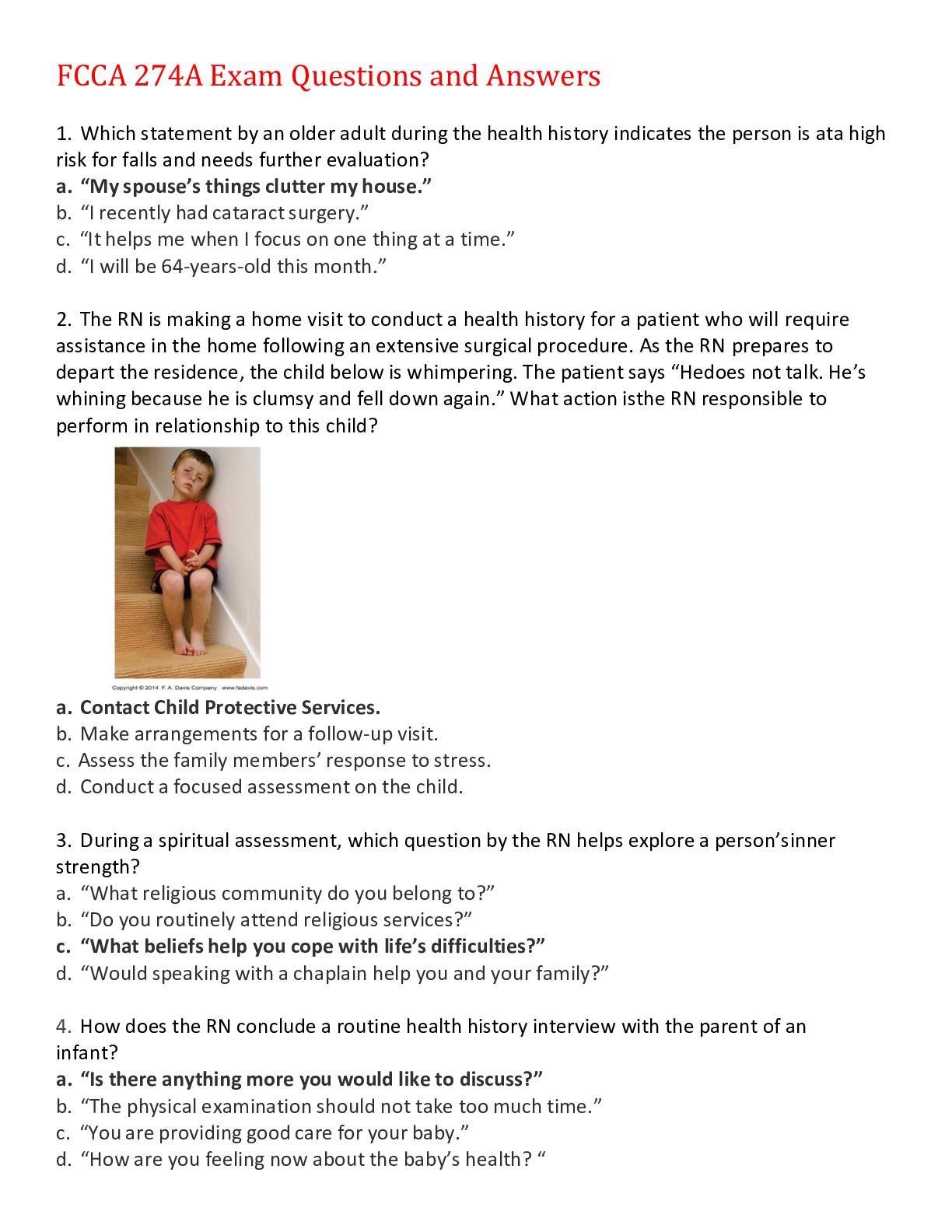
Buy this document to get the full access instantly
Instant Download Access after purchase
Add to cartInstant download
Also available in bundle (1)
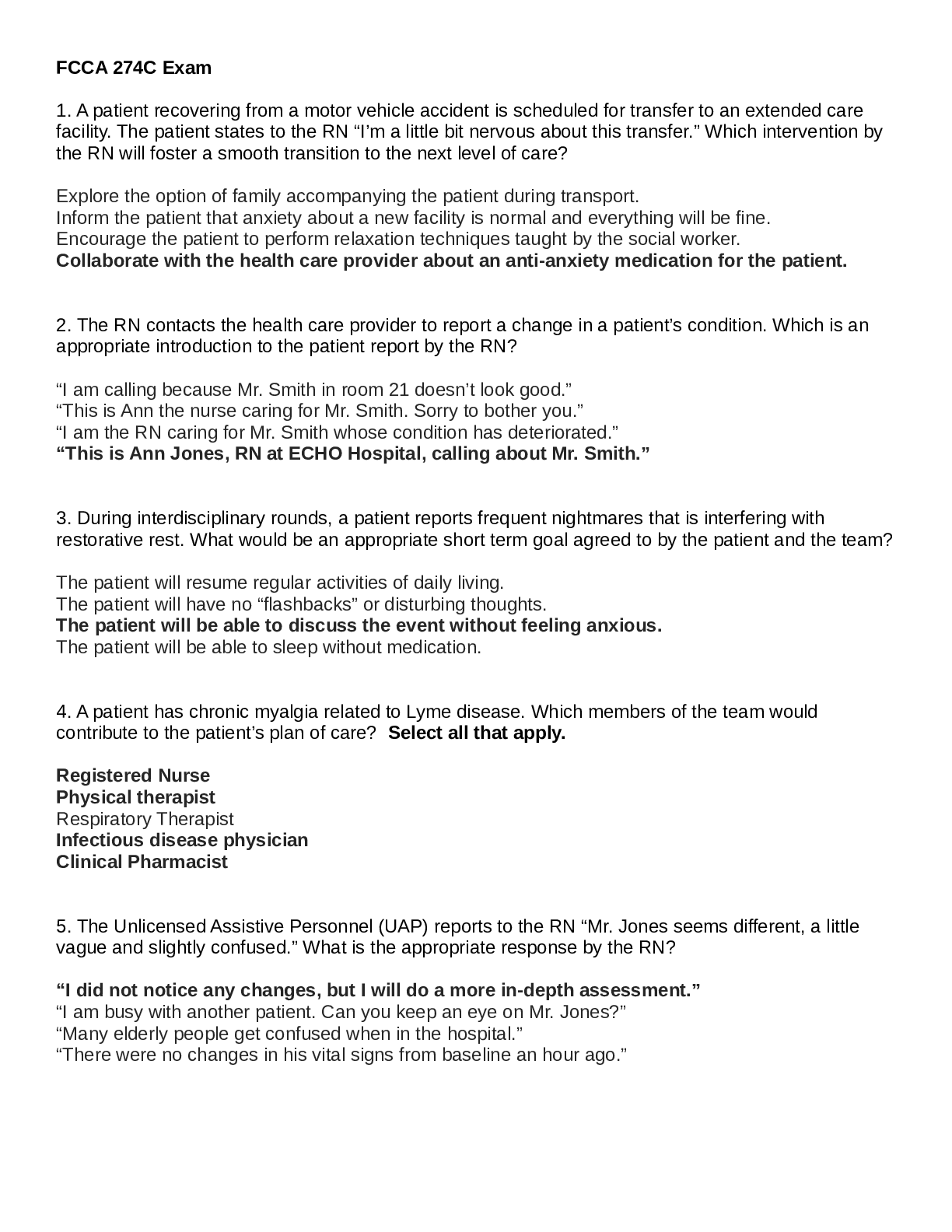
South University - FCCA 274 C / FCCA 274 C - FCCA 274 A / FCCA 274 A Exam LATEST AND GRADED A+
South University - FCCA 274 A / FCCA 274 A Exam LATEST AND GRADED A+ South University - FCCA 274 C / FCCA 274 C Exam LATEST AND GRADED A+
By merit95 3 years ago
$26
2
Reviews( 0 )
Document information
Connected school, study & course
About the document
Uploaded On
May 04, 2021
Number of pages
26
Written in
Additional information
This document has been written for:
Uploaded
May 04, 2021
Downloads
0
Views
101

